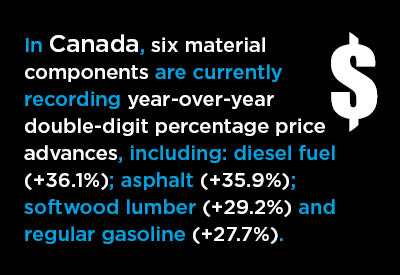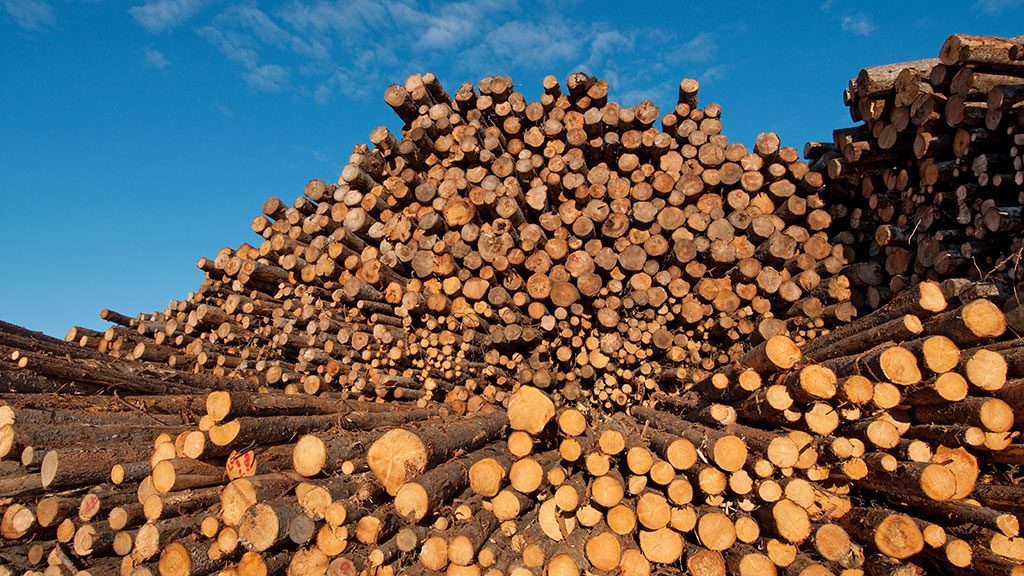In several of my recent articles (“U.S. Construction Costs Are Soaring“; “Costs of Service, Commodity and Energy Inputs Into Construction Are Heating Up“; and “Infographic: Construction is costing more“), there have been close looks at construction material cost movements in the U.S. as captured by the Bureau of Labor Statistics (BLS)’s Producer Price Index (PPI) data series.

PPI numbers are ‘factory gate’ prices. They are what producers and providers receive for their goods and services when they ‘go out the door’. They do not include subsequent transportation and wholesaling charges. Also, they are domestic only, leaving out imports.
The equivalent numbers for Canada are to be found in the Industrial Product Price Index (IPPI) and Raw Materials Price Index (RMPI) data series. The accompanying table sets out price movements for key construction materials and components north of the border.
Many of the same products are seeing similar large price hikes in Canada as in the U.S. Most of the biggest spikes are being driven by forest product, steel and energy inputs.
Six material components are currently recording year-over-year double-digit percentage price advances: diesel fuel (+36.1%); asphalt (+35.9%); softwood lumber (+29.2%); regular gasoline (+27.7%); prefabricated metal buildings (+15.3%); and waferboard and particle board (+11.6%).
The type-of-structure indices at the top of Table 1 have been calculated by CanaData based on separate weightings. For example, energy products play big roles in engineering construction (e.g., asphalt for roads and highways), whereas forestry products figure crucially in residential construction.
The material input indices range from a low of +4.5% year over year for nonresidential building to a high of +9.2% for engineering/civil construction. The residential construction index is +5.1% y/y. The ‘total construction’ index is +6.6%.
While +6.6% is a big jump, it doesn’t quite rise to the +8.1% current level for the ‘inputs to all new construction’ PPI index in the U.S.
Of course, materials are not alone in determining construction costs. Margins and labour also stir the pot. While there is minimal data available on margins, Statistics Canada does publish figures on ‘weekly earnings in construction, including overtime’ (Table 14-10-0223-01). (The high-level numbers for all industries appear in the publication Payroll Employment, Earnings and Hours.)
According to Statistics Canada, weekly compensation in construction in June was +6.0% y/y nation-wide. Regionally, Quebec (+10.2%) led the way, followed by British Columbia (+8.0%) and Ontario (+7.4%). Among Canada’s four largest provinces by population, Alberta was the laggard (+3.5%).
Raw Materials Price Index (RMPI) Results
% Change in the July 2018 Index from:
| 3 Years | 1 Year | 6 Months | 3 Months | 1 Month | |||
| Ago | Ago | Ago | Ago | Ago | |||
| Type of Construction Indices: | |||||||
| Residential | 16.0% | 5.1% | 6.3% | 3.4% | 0.3% | ||
| Non-residential Building | 8.3% | 4.5% | 2.8% | 1.5% | 0.2% | ||
| Engineering/Civil | 12.3% | 9.2% | 5.7% | 4.1% | 1.0% | ||
| Total Construction | 13.0% | 6.6% | 5.4% | 3.3% | 0.6% | ||
| Key Aggregates: | |||||||
| Lumber and other wood products | 20.7% | 10.7% | 10.6% | 5.6% | 0.4% | ||
| Primary ferrous metal products | 8.5% | 8.1% | 10.6% | 4.0% | 0.2% | ||
| Primary non-ferrous metal products | 14.2% | 7.8% | -0.5% | -1.7% | -3.3% | ||
| Fabricated metal products and construction materials | 13.4% | 6.2% | 5.2% | 3.0% | 0.2% | ||
| Machinery and equipment (includes HVAC) | 4.1% | 2.2% | 2.1% | 1.4% | 0.0% | ||
| Electrical, electronic and telecommunications | 1.8% | 1.7% | 2.3% | 1.3% | -0.4% | ||
| Cement, glass, other non-metallic minerals | 5.9% | 3.4% | 1.6% | 0.3% | 0.2% | ||
| Petroleum and coal products | 16.2% | 27.8% | 7.8% | 3.5% | -0.1% | ||
| Chemicals and chemical products | 0.5% | 4.1% | 0.0% | 0.3% | -0.5% | ||
| Construction Inputs: | |||||||
| Softwood lumber (spruce-pine-fir) | 48.0% | 29.2% | 18.8% | 7.5% | -3.8% | ||
| Veneer and plywood | 21.6% | 6.6% | 10.3% | 2.9% | -1.6% | ||
| Waferboard and particle board | 52.4% | 11.6% | 20.9% | 13.4% | 4.9% | ||
| Shakes and shingles and wood siding | -5.9% | -2.8% | -0.9% | -3.1% | 0.2% | ||
| Wood windows and doors | 3.8% | 1.4% | 1.1% | 1.0% | 0.0% | ||
| Glass and glass products (except automotive) | 4.9% | 6.3% | 6.2% | 2.6% | 0.2% | ||
| Ready-mix concrete | 6.2% | 2.4% | -0.8% | 0.0% | 0.0% | ||
| Clay products (brick) | 15.0% | -0.5% | 3.1% | 3.3% | 0.0% | ||
| Fabricated structural metal | 14.3% | 7.7% | 6.6% | 3.9% | 0.5% | ||
| Prefabricated metal buildings | 20.2% | 15.3% | 17.0% | 5.7% | 1.4% | ||
| Metal windows and doors | 13.3% | 2.1% | 3.6% | 0.0% | 0.0% | ||
| Metal roofing | 11.8% | 3.0% | 2.9% | 4.7% | 0.2% | ||
| Bolts, nuts, screws, washers, fasteners | 14.1% | 4.1% | 0.8% | 0.3% | 0.1% | ||
| Hardware | 5.7% | 3.1% | 3.0% | 1.1% | 0.0% | ||
| Plastic pipe fittings | 2.9% | -0.4% | 0.0% | 0.0% | 0.0% | ||
| Plastic plumbing fixtures | 10.0% | 4.0% | 2.2% | 0.4% | 0.0% | ||
| Electric lamps, lighting fixtures | -3.5% | -2.2% | -1.6% | -2.6% | 0.0% | ||
| Concrete pipes and fittings | 2.5% | 0.5% | 1.8% | 0.0% | 0.0% | ||
| Asphalt | 25.6% | 35.9% | 38.6% | 32.8% | 10.8% | ||
| Gasoline (regular) | 11.8% | 27.7% | 12.6% | 2.2% | 0.7% | ||
| Diesel fuel | 27.6% | 36.1% | 3.5% | 2.7% | -1.3% | ||
| Natural gas | -6.0% | -6.7% | -2.6% | -0.3% | 0.2% | ||
| Gypsum | 19.7% | 7.7% | 8.8% | 0.1% | 1.3% | ||
| Iron ore | 29.9% | 1.1% | -8.4% | 3.5% | 0.0% | ||
| Stone | 8.7% | 4.1% | 6.0% | 1.2% | 0.6% |
Table: ConstructConnect.











Recent Comments
comments for this post are closed